Introduction
Quick Navigation
Birds are lovely creatures that fly, sing, and generally fill our airspace with vitality and warmth. They are quite different from your regular mammal, reptile, and amphibian though they might share some similarities. Most birds fly, even water birds, while others are not flight-enabled. This does not change the fact that they are birds, as their features and body structures agree with the aviary world. Several birds live and grow in the wild, while a few others have successfully been domesticated. These domestic birds, even though they are kept as pets, are still allowed some measure of freedom, as birds naturally are free creatures. Wild birds, on the other hand, roam natural grasslands, forests, and open fields where they live in their natural habitats. Some wild birds can also be found in suburban and urban centers as a lot of them are people-friendly.
See also; sounds of cardinals
It is important to note that not all animals are evenly distributed worldwide. Certain animals can only be found in specific regions and locations. This concept also applies to members of the aviary world. Certain birds can only be found in particular areas, and even when they are introduced elsewhere, their region of nativity remains as they are likely to have more population there. Knowing the differences between birds native to a region and those that have been introduced is a skill that every birder desires. Of course, this can be stated in bird guides and magazines, but there is a thrill in the heart of birders when they can tell these differences by sight alone.
Check also; cardinal symbolism and spiritual meanings
Birding is more common in continents like Europe and North America as the population of birds resident in the regions is pretty high. America, as a country, is rich in wildlife resources which include various animals and birds. This is also partially responsible for the influx of tourists who visit the country increasing every year as birders are known to travel in search of different bird species. The sight of a group or groups of people clustered together with their binoculars in hand and staring into the sky is as common as the sight of the sun itself in several American states. The state of Wisconsin is not excluded from the list of birding havens in the United States.
See this; can birds eat raisins
Environmental description of Wisconsin
The Badger state, which is the state’s nickname, is also located in the upper Mid-western region of the United States and is home to over five million people of diverse cultural backgrounds, with its capital city called Madison. Today, the state’s cultural atmosphere and roots are greatly influenced by foreign elements such as Scandivanian myths and German folklore. Wisconsin is a major producer of dairy foods which is a huge contributor to its economy and is quite famous for its cheese. Beer production, manufacturing, information technology, and tourism are other sources of revenue for the state.
Like the other states surrounding Wisconsin, its physical landscape and natural environment are relatively abundant and quite flourishing. The state is dotted by several lakes and streams, and grasslands for farming and agriculture. Wildlife areas, birding trails, environmental centers, and woodland parks are also numerous this making this state a perfect choice for birding. This American state is home to numerous bird species, most of which are permanent residents.
Check also; can birds eat almonds
Birds native to Wisconsin
The high number of bird species present in Wisconsin has earned it the right to be called a birding state. There are about four hundred and forty different species of birds that are frequently and commonly sighted in this state. Some of them include Ross’s goose, mute swan, Spruce grouse, gray partridge, chimney swift, yellow rail, sandhill crane, piping plover, Whimbrel, and Hudsonian godwit.
Ross’s goose
This bird is quite similar in physical appearance to the snow goose, but it is distinguished by its wingtips which are black and it,s short neck, and it is regarded as the smallest in a set of white geese with which it shares a resemblance. It is a native bird to the state of Wisconsin and usually inhabits areas with vegetation like patches and willows. This migratory bird, like other similar species, feeds on grasses and grains. This beautiful bed can be quite exciting to watch as they forage in a very peculiar manner.
See also; birds of missouri
Mute swan
These waterbirds are large, white in plumage with an orange beak that makes them easily recognizable. Their name was derived from the fact that they are less noisy and vocal when compared to other swan species. Their physical appearance and graceful movements are the first things that catch every birder’s eye. They are often found in shallow waters and lakes with low water levels where they build nests in the form of mounds made out of water grasses. These monogamous species are highly territorial with a diet that consists mainly of water plants and other small invertebrates. These birds are less vocal and not entirely silent, as their name suggests. Their aggressive nature comes into focus in defense of their young ones, and they are known to grieve for a dead young one or mate.
Spruce grouse
It is a medium-sized member of the grouse family mostly known for perching and moving on trees and relies significantly on camouflage to escape predators. It commonly occupied coniferous forests where it feeds on berries, berry leaves, fungi, and some small insects.
Gray partridge
This game bird is very common in Wisconsin as it can be seen in both urban and rural areas in large numbers. However, their numbers are gradually decreasing due to land cultivation that results in the loss of habitats. They are commonly seen in groups and flocks and are non-migratory flying creatures.
Check also; birds of tennessee
Chimney swift
This medium-sized bird species is incapable of perching and can only hold on to vertical surfaces, mostly feeding on airborne insects and spiders. This bird mates for life and is frequently sighted in Wisconsin.
Conclusion
Birds remain fascinating creatures to watch and observe, which is why birding is steadily embraced and encouraged.

